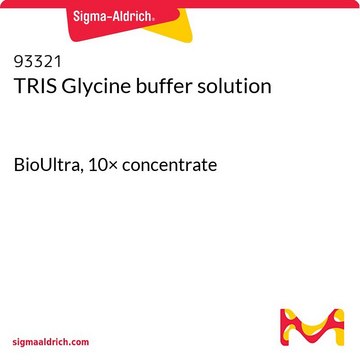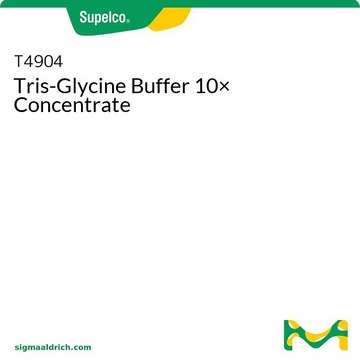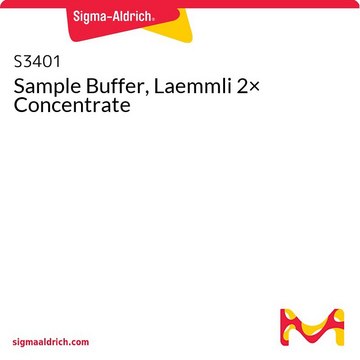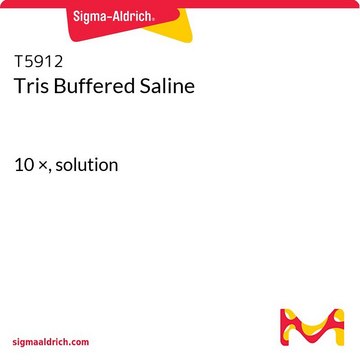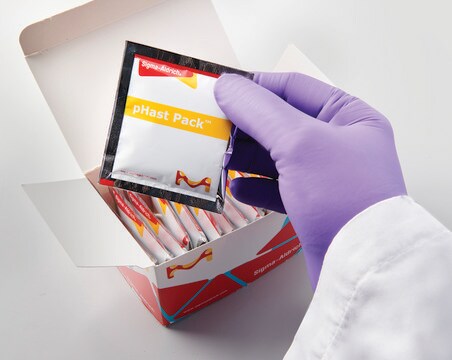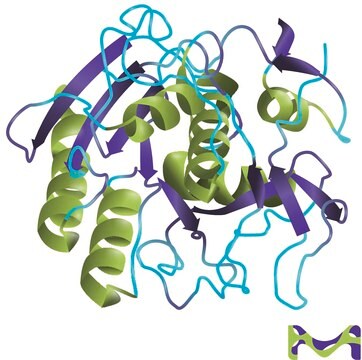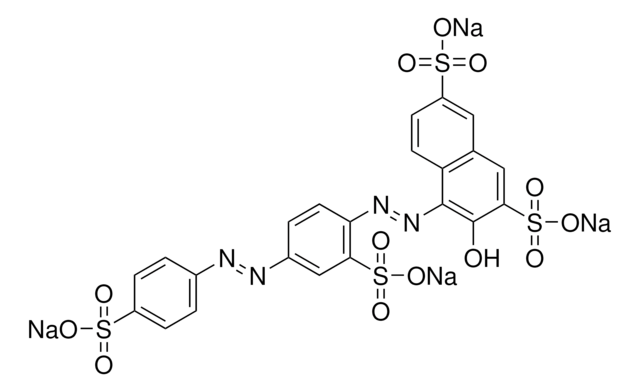T7777
Tris-Glycine-SDS Buffer 10× Concentrate
Synonim(y):
TRIS glycine SDS buffer solution
Zaloguj sięWyświetlanie cen organizacyjnych i kontraktowych
About This Item
Kod UNSPSC:
41105319
eCl@ss:
32129211
NACRES:
NA.25
Polecane produkty
sterylność
0.2 μm filtered
Formularz
liquid
Zastosowanie
diagnostic assay manufacturing
temp. przechowywania
2-8°C
Szukasz podobnych produktów? Odwiedź Przewodnik dotyczący porównywania produktów
Opis ogólny
Tris-glycine-SDS (TGS) running buffer is the most commonly used buffer for sodium dodecyl sulfate-polyacrylamide gel electrophoresis (SDS-PAGE) of proteins. TGS is usually used for both anode and cathode buffer. Recommended running conditions is 150 volts for mini vertical gel electrophoresis units.
Zastosowanie
Tris-glycine-SDS buffer 10× concentrate has been used as a running buffer in sodium dodecyl sulfate-polyacryamide gel electrophoresis (SDS-PAGE). It is also used to block membranes with 5% non-fat dry milk for western blotting. TGS is usually used for both the anode buffer and the cathode buffer. Recommended running conditions is 150 volts for mini vertical gel electrophoresis units.
Rekonstytucja
Dilution of the 10× TGS buffer produces a 1× running buffer containing 25 mM Tris, 192 mM glycine and 0.1% SDS, pH approx. 8.6.
Ta strona może zawierać tekst przetłumaczony maszynowo.
Kod klasy składowania
10 - Combustible liquids
Klasa zagrożenia wodnego (WGK)
WGK 1
Temperatura zapłonu (°F)
Not applicable
Temperatura zapłonu (°C)
Not applicable
Środki ochrony indywidualnej
Eyeshields, Gloves, type ABEK (EN14387) respirator filter
Wybierz jedną z najnowszych wersji:
Masz już ten produkt?
Dokumenty związane z niedawno zakupionymi produktami zostały zamieszczone w Bibliotece dokumentów.
Antitumor Activity and Mechanism of a Reverse Transcriptase Inhibitor, Dapivirine, in Glioblastoma
Liu W, et al.
Journal of Cancer, 117?128-117?128 (2018)
Multiple tandem epitope tagging for enhanced detection of protein expressed in mammalian cells
Zhang L, et al.
Molecular Biotechnology, 19(3), 313-321 (2001)
A Radioisotope-free Oligosaccharyltransferase Assay Method
Yamasaki T and Kohda D
Glycobiology (2007)
Man-Lan Guo et al.
Cell biochemistry and function, 37(2), 72-83 (2019-02-19)
Cancer cell progression and proliferation increase cell density, resulting in changes to the tumour site, including the microenvironment. What is not known is if increased cell density influences the aggressiveness of cancer cells, especially their proliferation, migration, and invasion capabilities.
Weiwen Liu et al.
The Journal of dermatology, 48(3), 289-300 (2020-12-02)
Androgenetic alopecia is the most common form of hair loss disorder. The features of this process are shortening of the anagen phase in hair cycling and progressive miniaturization of the hair follicle. However, the mechanisms in androgenetic alopecia are still
Nasz zespół naukowców ma doświadczenie we wszystkich obszarach badań, w tym w naukach przyrodniczych, materiałoznawstwie, syntezie chemicznej, chromatografii, analityce i wielu innych dziedzinach.
Skontaktuj się z zespołem ds. pomocy technicznej